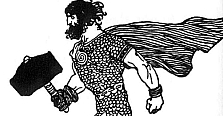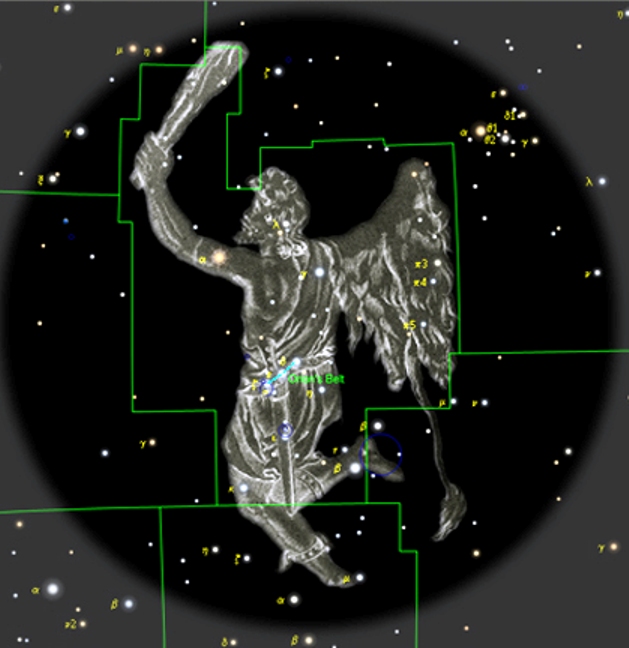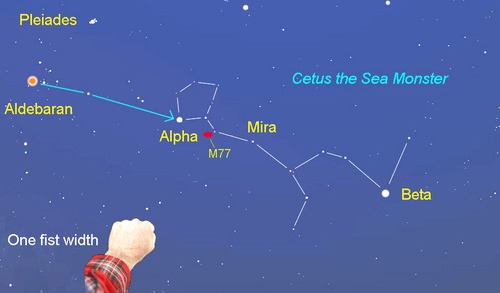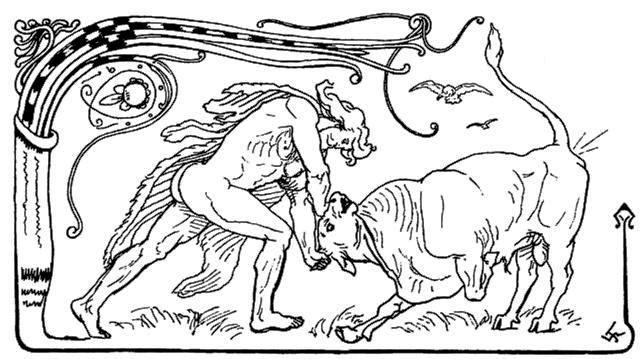
Thor's Iron Glove:
Járnglófar/ Járngreiprby Peter Krüger
©2012
[Germanic Astronomy]
| Hann á ok þrjá kostgripi.
Einn þeira er hamarrinn Mjöllnir, er hrímþursar ok bergrisar kenna, þá
er hann kemr á loft, ok er þat eigi undarligt. Hann hefir lamit margan
haus á feðrum eða frændum þeira. Annan grip á hann beztan, megingjarðar,
ok er hann spennir þeim um sik, þá vex honum ásmegin hálfu. Inn þriðja
hlut á hann, þann er mikill gripr er í. Þat eru járnglófar. Þeira má
hann eigi missa við hamarskaftit. En engi er svá fróðr, at telja kunni
öll stórvirki hans, en segja kann ek þér svá mörg tíðendi frá honum, at
dveljast munu stundirnar, áðr en sagt er allt, þat er ek veit." |
He has also three things of great price: one is the hammer Mjöllnir, which the Rime-Giants and the Hill-Giants know, when it is raised on high; and that is no wonder, it has bruised many a skull among their fathers or their kinsmen. He has a second costly thing, best of all: the girdle of might; and when he clasps it about him, then the godlike strength within him is increased by half. Yet a third thing he has, in which there is much virtue: his iron gloves; he cannot do without them when he uses his hammer-shaft. But no one is so wise that he can tell all his mighty works; yet I can tell thee so much tidings of him that the hours would be spent before all that I know were told." |
I showed in other posts that the hammer Mjölnir and the girdle Megingjarðar are in an astronomical sense asterisms. Mjölnir is identical to the star cluster of the Pleiades. Their rising indicates the start of summer and their setting the start of winter. This is why they are the automatic foe of the hrímþursar, constellations setting at the rising of the Pleiades and representing winter times.
I also showed that the girdle Megingjarðar is the most famous stellar girdle: the three stars of the nearby girdle of Orion.



In addition this asterism can explain some obscure details in other stories. In Skáldskaparmál Thor uses in his fight with Geirröd not his hammer to smash the giant but the glove Járngreipr to throw back a piece of hot iron. I assume the story describes the rising of the head of Cetus and the setting of Böotes (Geirröd) and the bright star Arcturus (the hot piece of iron). The tongs Geirrödr is using could be the claws of Scorpio, the iron pillar he is hiding behind is the Milky Way in the Sagittarius/Scorpio region.
In the Hrungnir myth, Magni complains that he arrived to late to help his father Thor in the fight and that he would haved used his fist to smash him (= the head of Cetus (the fist of Magni) is rising after the rising of the Pleiades/Mjölnir who already killed Hrungnir). At least he can help his father by removing a foot he is laying below (= the first star of Taurus is the star Elnath being at the same time the foot of Auriga and the horn of Taurus) so that Taurus/Thor is able to rise over the horizon. Magni is given the horse Gullfaxi, the constellation Aries next to the head of Cetus.

The "hand of Thor" appears also in
the story about the caught of Loki after the death of Balder. Loki is hiding
below a waterfall (= the water pouring out of the urn of Aquarius) in the
shape of a salmon (Piscis Australis). Thor is said to hold with his hand a
net. I assume that here also the other two parts of Cetus appear! The net is
formed by the body of Cetus having indeed a circular structure and being in
front of Piscis Australis and the net being connected with the head of
Cetus, the hand, by a straight line of stars.
Loki twice jumps over the net, which could be a reference to Pisces, the pair of fish, above the body of Cetus. In the end Thor (Taurus) snatches Loki by hand (= head of Cetus) and not with the net (= body of Cetus). Surely a reference to that the body of Cetus already was setting wheras Pisces and the head of Cetus were still above the horizon).
Loki twice jumps over the net, which could be a reference to Pisces, the pair of fish, above the body of Cetus. In the end Thor (Taurus) snatches Loki by hand (= head of Cetus) and not with the net (= body of Cetus). Surely a reference to that the body of Cetus already was setting wheras Pisces and the head of Cetus were still above the horizon).
x